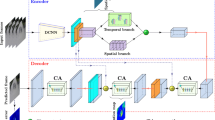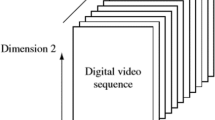Abstract
In the era of big data, the gap between the fast increasing size of the surveillance video data and the relatively stable video compression rate has become prominent. Existing data compression methods based on the known redundancies are not able to eliminate the dominant redundancy embedded in the big surveillance video data (BSVD) of multiple sources in large time span. In this study, a new approach based on global redundancy of the BSVD has been explored. We first analyze the compositions of the global redundancy based on characteristics of BSVD. A coding framework is proposed to eliminate global redundancy. Simulated experiments have been performed to examine the performance of the approach in comparison with the high efficiency video coding. The experimental result showed that the proposed approach can reach a compression rate of 1/400 for a huge dataset of surveillance videos.








Similar content being viewed by others
References
EMC. The Digital Universe in 2020: Big Data, Bigger Digital Shadows, and Biggest Growth in the Far East. 2012; Available from: http://www.emc.com/leadership/digital-universe/iview/big-data-2020.htm
Sullivan, G.J., et al.: Overview of the high efficiency video coding (HEVC) standard. IEEE Trans. Circuits Syst. Video Technol. 22(12), 1649–1668 (2012)
Wiegand, T.S., G.J.: Overview of the H.264/AVC video coding standard. IEEE Trans. Circuits Syst. Video Technol. 13(7):560–576 (2003)
ISO/IEC., (2001 March). Overview of the MPEG-4 Standard. Consultado el
Xiong, H.: Sparse spatio-temporal representation with adaptive regularized dictionary learning for low bit-rate video coding. IEEE Trans. Circuits Syst. Video Technol. 23(4), 710–728 (2013)
Xu, M.: Compressibility constrained sparse representation with learnt dictionary for low bit-rate image compression. IEEE Trans. Circuits Syst. Video Technol. 24(10), 1743–1757 (2014)
Liu, D.: Image compression with edge-based inpainting. IEEE Trans. Circuits Syst. Video Technol. 17(10), 1273–1287 (2007)
Zhu, C.: Video coding with spatio-temporal texture synthesis and edge-based inpainting. In: 2008 IEEE International Conference on Multimedia and Expo, 2008 June. pp. 813–816
Gao, W., et al.: IEEE 1857 standard empowering smart video surveillance systems. Intell. Syst. 29(5), 30–39 (2013)
Differential quantization of communication signals: by Cutler. C.C, Google Patents (1952)
Graphics & Media Lab Video Group, Lossless Video Codecs Comparison, 2007, Moscow State University
Kang, J.-W.: Sparse/DCT (S/DCT) two-layered representation of prediction residuals for video coding. IEEE Trans. Image Process. 22(7), 2711–2722 (2013)
Weinzaepfel, P.: Reconstructing an image from its local descriptors. In: 2011 IEEE Conference on Computer Vision and Pattern Recognition (CVPR). 2011 June, pp. 337–344
Yue, H.: Cloud-based image coding for mobile devices-toward thousands to one compression. IEEE Trans. Multimed. 15(4), 845–857 (2013)
Zhu, C.: Video coding with spatio-temporal texture synthesis. In: 2007 IEEE International Conference on Multimedia and Expo. 2007 July, pp. 112–115
Zhang, X.: Background-modeling-based adaptive prediction for surveillance video coding. IEEE Trans. Image Process. 23(2), 769–784 (2014)
Forchheimer, R.: Low bit-rate coding through animation. In: Proceedings of the International Picture Coding Sysmposium PCS‘83: p. 113–114 (1983)
Hakeem, A., Shafique, K., and Shah. M.: An object based video coding framework for video sequences obtained from static cameras. In: ACM International Conference on Multimedia. 2005, pp. 608–617
ISO/IEC., Text of ISO/IEC 14496–10:200X/FDAM 1 Multi-view Video Coding, (2008)
Vetro, A., Wiegand, T., Sullivan, G.J.: Overview of the stereo and multiview video coding extensions of the H.264/MPEG-4 AVC standard. Proc. IEEE. 99(4), 626–642 (2011)
Barnich, O., Van Droogenbroeck, M.: ViBe: a universal background substraction algorithm for video sequences. IEEE Trans. Image Process. 20(6), 1709–1724 (2011)
Tan, T.N., Sullivan, G.D., Baker, K.D.: Model-based localisation and recognition of road vehicles. Int. J, Comput. Vis. 27(1), 5–25 (1998)
Wang, Lizhe, Kunze, Marcel, Tao, Jie, von Laszewski, Gregor: Towards building a cloud for scientific applications. Adv. Eng. Softw. 42(9), 714–722 (2011)
Wang, Lizhe, von Laszewski, Gregor, Younge, Andrew J., He, Xi, Kunze, Marcel, Tao, Jie: Cloud computing: a perspective study. New Gener. Comput. 28(2), 137–146 (2010)
Ma, Yan, Wang, Lizhe, Zomaya, Albert Y., Chen, Dan, Ranjan, Rajiv: Task-tree based large-scale mosaicking for massive remote sensed imageries with dynamic DAG scheduling. IEEE Trans. Parallel Distrib. Syst. 25(8), 2126–2137 (2014)
Wang, L., Ma, Y., Ranjan, R., Zomaya, A.Y., Chen, D.: A parallel file system with application aware data layout policies in digital earth. IEEE Trans. Parallel Distrib. Syst. 99(PrePrints):1 (2014). doi:10.1109/TPDS.2014.2322362
Wang, L., Tao, J., Ranjan, R., Marten, H., Streit, A., Chen, J., Chen, D.: G-Hadoop: MapReduce across distributed data centers for data-intensive computing. Future Gener. Comp. Syst. 29(3), 739–750 (2013)
Wang, L., Khan, S.U., Chen, D., Kolodziej, J., Ranjan, R., Xu, C., Zomaya, A.: Energy-aware parallel task scheduling in a cluster. Future Gener. Comp. Syst. 29(7),1661–1670 (2013)
Chen, D., Li, X., Wang, L., Khan, S., Wang, J., Zeng, K., Cai, C..: Fast and scalable multi-way analysis of massive neural data. IEEE Trans. Comput. PP(99) (2014). doi:10.1109/TC.2013.2295806
Chen, D., Wang, L., Zomaya, A., Dou, M., Chen, J., Deng, Z., Hariri, S.: Parallel simulation of complex evacuation scenarios with adaptive agent models. IEEE Trans. Parallel Distrib. Syst. PP(99) (2014). doi:10.1109/TPDS.2014.2311805
Chen, D., Li, X., Cui, D., Wang, L., Lu, D.: Global synchronization measurement of multivariate neural signals with massively parallel nonlinear interdependence analysis. IEEE Trans. Neural Syst. Rehabil. Eng. 22(1), 33–43 (2014)
Chen, D., Li, D., Xiong, M., Bao, H., Li, X.: GPGPU-aided ensemble empirical-mode decomposition for EEG analysis during anesthesia. IEEE Trans. Inf. Technol. Biomed. 14(6), 1417–1427 (2010)
Acknowledgments
This work was partly supported by the EU FP7 QUICK project under Grant Agreement (PIRSES-GA-2013-612652), National Nature Science Foundation of China (No. 61271256), China Postdoctoral Science Foundation (2014M562058), Fundamental Research Funds for the Central Universities (2042014kf0025, 2042014kf0286, 2042014kf0212).
Author information
Authors and Affiliations
Corresponding author
Rights and permissions
About this article
Cite this article
Xiao, J., Liao, L., Hu, J. et al. Exploiting global redundancy in big surveillance video data for efficient coding. Cluster Comput 18, 531–540 (2015). https://doi.org/10.1007/s10586-015-0434-z
Received:
Revised:
Accepted:
Published:
Issue Date:
DOI: https://doi.org/10.1007/s10586-015-0434-z




